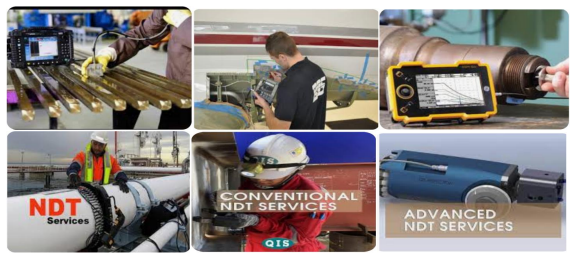Overview
AKTINES Services
provides Inspection Team for Construction Project and Plant Reliability
& Inspection Team to Oil & Gas, Petrochemicals, Fertilizers, Mining &
Steel, Power & Utilities sectors etc.
In the Construction Projects,
AKTINES Services
can provide Qualified QA/QC Engineers / Inspectors (Mechanical,
Electrical, Piping, Static, Refractory, Corrosion, Welding and NDT).
All the inspection activities are conducted as per the International
Standard and Client's requirement.
AKTINES Services
can provide complete inspection teams from Projects execution to
Maintenance.
The Reliability Teams are capable of Asset Integrity Management, Risk
Based Inspection, Inspection Management Services, Plant Life Management
and Third-Party Inspections etc.
Our Reliability Resources include but are not limited to Rotating
Equipment Engineers specialized in RCM/RBM with specialization in
Bentley Systems, Corrosion Engineers with NACE Certification, Refractory
Engineers, Catalyst Specialists.
What is Non-Destructive Testing (NDT)> Non-destructive testing
(NDT)
is a testing and analysis technique used by industry to evaluate the
properties of a material, component, structure or system for
characteristic differences or welding defects and discontinuities
without causing damage to the original part. NDT also known as
non-destructive examination (NDE), non-destructive inspection (NDI) and
non-destructive evaluation (NDE).
What is the Difference Between Destructive and Non-Destructive
Testing
Destructive testing destroys or changes the part in some way such that
even if it passes the test it is no longer fit for service. Examples
might be tensile testing, 3 point bend test or macro sectioning. NDT
does not destroy or change the part such that it is still fit for
service if it passes the test.
What are the Advantages of using NDT
There are a number of distinct advantages, the most obvious of which is
that the pieces being tested are left undamaged by the process, allowing
for an item to be repaired rather than replaced should any problems be
found. It is also a very safe testing method for operators, with most
techniques being harmless to humans, although some types of test - such
as radiographic testing - still need to be conducted under strict
conditions. This testing technique can also help prevent injury or
fatalities by ensuring structures, components and machinery is safe.
Digital Radiography - Non-Destructive Testing (NDT)
Non-destructive testing is also a very accurate way of inspection since
the tests are repeatable and a number of tests can be used together to
correlate results. These testing methods are also economical. Unlike
destructive testing, NDT is cost effective as it can prevent the need to
replace an item before malfunction occurs without destroying the piece
itself. This testing technique also offers operators peace of mind,
knowing that equipment is functioning as it should, preventing future
accidents and determining any measures that can be taken for life
extension. It is also useful for testing of welds and verification of
welding procedures to ensure that a welding process has been completed
to the correct specification within the bounds of quality control, for
example to make sure that the base metal has reached the correct
temperature, cooled at the specific rate and that compatible materials
have been used to prevent welding defects.
Radiography : is an imaging
technique using X-rays, gamma rays, or similar ionizing radiation and
non-ionizing radiation to view the internal form of an object.
Applications of radiography include medical radiography and industrial
radiography. Similar techniques are used in airport security
Liquid Penetrant Testing : The
handbook outlines the principles, equipment, materials maintenance,
methodology, and interpretation skills necessary for liquid penetration
testing.
Industrial radiography :Industrial radiography is a modality of non-destructive testing that
uses ionizing radiation to inspect materials and components with the
objective of locating and quantifying defects and degradation in
material properties that would lead to the failure of engineering
structures.
Visual inspection : Visual
inspection is a common method of quality control, data acquisition, and
data analysis. Visual Inspection, used in maintenance of facilities,
mean inspection of equipment and structures using either or all of raw
human senses such as vision, hearing, touch and smell and/or any
non-specialized inspection equipment. Inspections requiring Ultrasonic,
X-Ray equipment, Infra-red, etc. are not typically regarded as visual
inspection as these Inspection methodologies require specialized
equipment, training and certification
Magnetic particle inspection :
Magnetic particle Inspection is a nondestructive testing process for
detecting surface and shallow subsurface discontinuities in
ferromagnetic materials such as iron, nickel, cobalt, and some of their
alloys. The process puts a magnetic field into the part.
Eddy-current testing :
Eddy-current testing is one of many electromagnetic testing methods used
in nondestructive testing making use of electromagnetic induction to
detect and characterize surface and sub-surface flaws in conductive
materials.
Infrared and thermal testing :
Infrared and thermal testing refer to passive thermographic inspection
techniques, a class of nondestructive testing designated by the American
Society for Nondestructive Testing. Infrared thermography is the science
of measuring and mapping surface temperatures.
Ultrasonic testing : Ultrasonic
testing is a family of non-destructive testing techniques based on the
propagation of ultrasonic waves in the object or material tested.
Ultrasound : Ultrasound is sound
with frequencies greater than 20 kilohertz. This frequency is the
approximate upper audible limit of human hearing in healthy young
adults. The physical principles of acoustic waves apply to any frequency
range, including ultrasound.
Dye penetrant inspection : Dye
penetrant inspection, also called liquid penetrate inspection or
penetrant testing, is a widely applied and low-cost inspection method
used to check surface-breaking defects in all non-porous materials.


